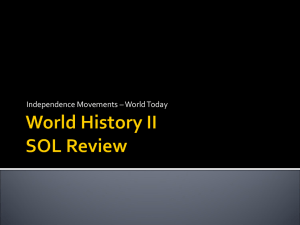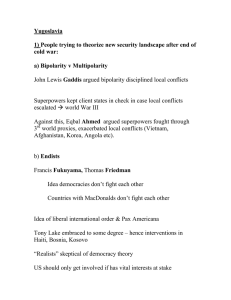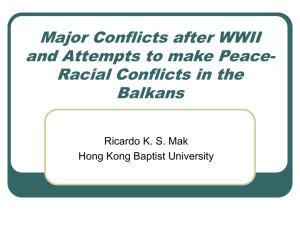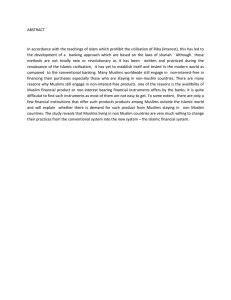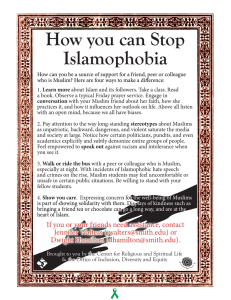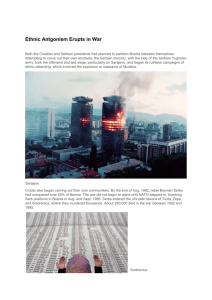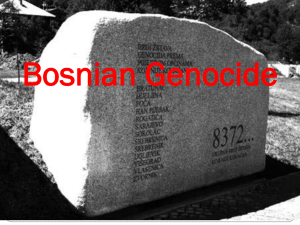Being Muslim the Bosnian Way - By: Tone Bringa Introduction-
advertisement
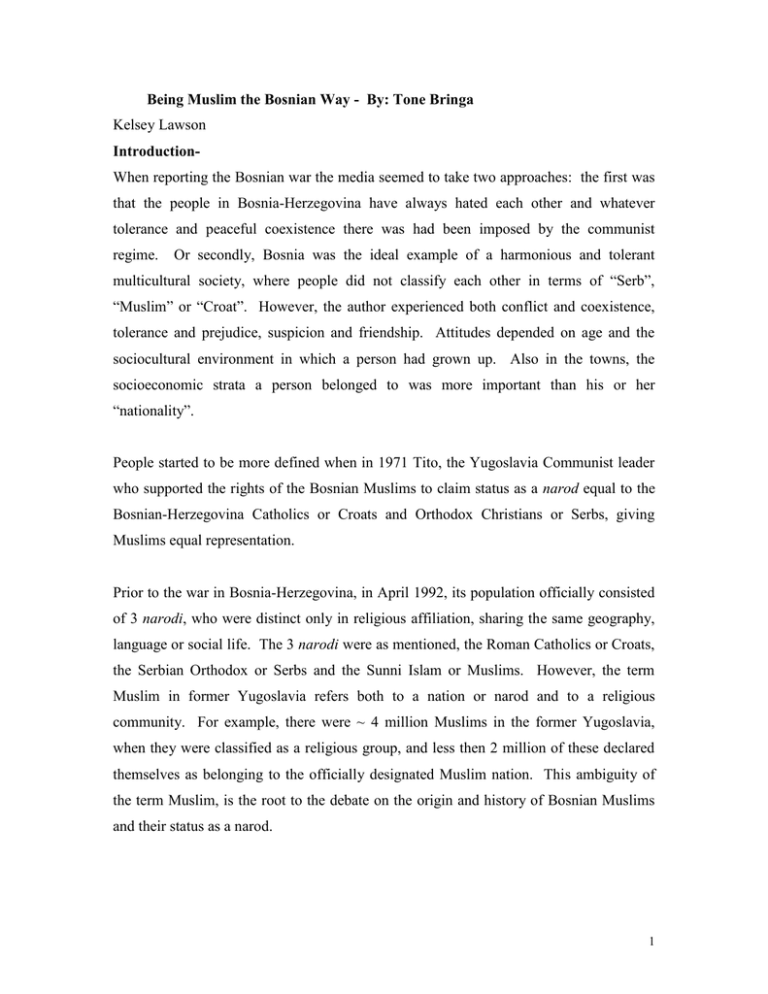
Being Muslim the Bosnian Way - By: Tone Bringa Kelsey Lawson IntroductionWhen reporting the Bosnian war the media seemed to take two approaches: the first was that the people in Bosnia-Herzegovina have always hated each other and whatever tolerance and peaceful coexistence there was had been imposed by the communist regime. Or secondly, Bosnia was the ideal example of a harmonious and tolerant multicultural society, where people did not classify each other in terms of “Serb”, “Muslim” or “Croat”. However, the author experienced both conflict and coexistence, tolerance and prejudice, suspicion and friendship. Attitudes depended on age and the sociocultural environment in which a person had grown up. Also in the towns, the socioeconomic strata a person belonged to was more important than his or her “nationality”. People started to be more defined when in 1971 Tito, the Yugoslavia Communist leader who supported the rights of the Bosnian Muslims to claim status as a narod equal to the Bosnian-Herzegovina Catholics or Croats and Orthodox Christians or Serbs, giving Muslims equal representation. Prior to the war in Bosnia-Herzegovina, in April 1992, its population officially consisted of 3 narodi, who were distinct only in religious affiliation, sharing the same geography, language or social life. The 3 narodi were as mentioned, the Roman Catholics or Croats, the Serbian Orthodox or Serbs and the Sunni Islam or Muslims. However, the term Muslim in former Yugoslavia refers both to a nation or narod and to a religious community. For example, there were ~ 4 million Muslims in the former Yugoslavia, when they were classified as a religious group, and less then 2 million of these declared themselves as belonging to the officially designated Muslim nation. This ambiguity of the term Muslim, is the root to the debate on the origin and history of Bosnian Muslims and their status as a narod. 1 For this ethnography the author was situated in a village in Bosnia called Dolina, living in an all-Muslim neighborhood, which meant that she had less contact with Catholics, or Croats in the village. Also, since she is a woman she was restricted to the world of women and excluded from the world of men. Consequently, her ethnography is written as seen mainly through the eyes of Muslim women. History, Identity, and the Yugoslav Dream: Chapter 1 Contested History ~ Historically, Bosnia-Herzigovina has been situated within 3 major political and ideological divisions: 1.) Byzantium and Rome 2.) Eastern & Western Christendom 3.) Catholic Austro-Hungarian Empire and the Islamic Ottoman Empire. Bosnia-Herzigovina was under Ottoman rule until taken over by the AustroHungarian dual kingdom in 1878. In modern times, Bosnia-Herzegovina’s major dividing line is between Catholic (Croatia) and the Orthodox (Serbia), and the Muslims (Bosnia). The history of the Bosnian Muslims has been contested, therefore so too is their ethnic origin and claim to status as a distinct narod. A debate over the legitimate owner of Bosnia and its territory. Heretical Bosnia ~ 3 main arguments explaining the reason of Conversion by the South Slavs to Islam during the Ottoman rule: 1.) Bosnian nobles converted in order to retain their property and privileges. 2.) The conversions were forced by the Ottoman Empire. 2 3.) Those that converted were members of the medieval Bosnian Church persecuted as “heretics” by the established Christian churches. 3 main religions that existed before the introduction of Islam: 1.) Heretics (Bogomils) 2.) Catholics 3.) Orthodox Christians. The Ethnic Dimension ~ Factors motivating people to retain their allegiance to a certain religious community: 1.) personal conviction 2.) political, social or economic interests. In Bosnia a persons name tells you who they are, reflecting his trade, status or was an honorary title or showed religious preference. The Muslims as a Bosnian Nacija ~ Ottomans established an administrative scheme, the millet system, whereby membership in a “nation” was determined by religious affiliation. Result of which was that it created collective cultural identities based on membership of a religious community – Muslims, Catholic Croats, and Orthodox Serbs. Nacija – enthoreligious identity and community – Orthodox, Catholic, Islam Muslims. Tito’s Socialist Yugoslavia ~ - 1918 – Yugoslavia was founded as the kingdom of Serbs, Croats and Slovenes by Karadordevic. -Partisans, led by Tito, liberated country from the Germans & their allies. - 1945 – Yugoslavia was declared a Federal Socialist Republic, which lasted until 1991. 3 - World war II and the Partisans war of liberation, a Serb-Croat war and a Serbian civil war. - 1948 – no longer under the Soviet sphere of influence. - Form of self-managing socialism, between the communist central and eastern European states and the capitalist west. - 1991 – Croatia & Slovenia declared independence and war broke out shortly after. - 1992 – Bosnia-Herzegovina has a referendum and declares independence, war broke out a month later. - Tito’s nationalist policies, modeled after Stalin’s, main characteristic was the prominent role of the state in defining nationalities within its borders. - “nations of Yugoslavia” – Serb, Croat, Slovene, Macedonian, Montenegrin, and Muslim. - “nationalities of Yugoslavia” – Albanians & Hungarians. -“other nationalities and ethnic minorities” – Jews, Greeks, Russians, etc. - Transition from a centralist Yugoslav federation toward one of Yugoslavia as a federation of national republics after 1971. Competing Nationalisms and the Denial of a Bosnian Identity ~ Croat and Serb nationalist politicians dismissed the Muslims as an “invented people”, and claimed they were either Serbs or Croats respectively. The Bosnjavstvo Debate – “Bosnianhood” 4
